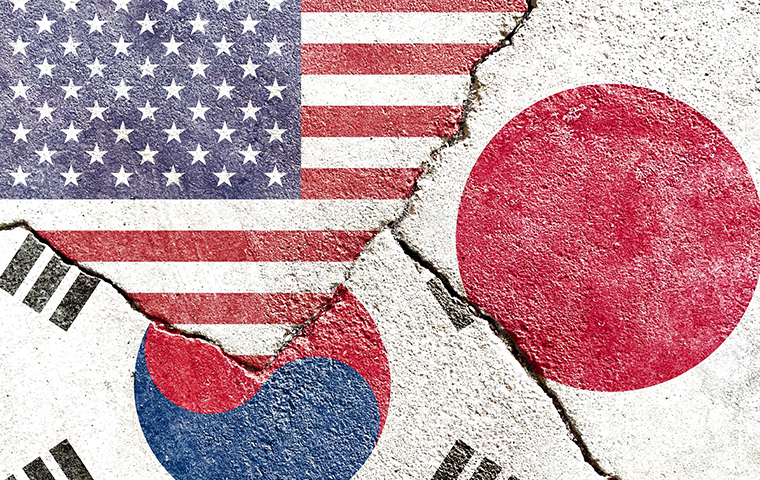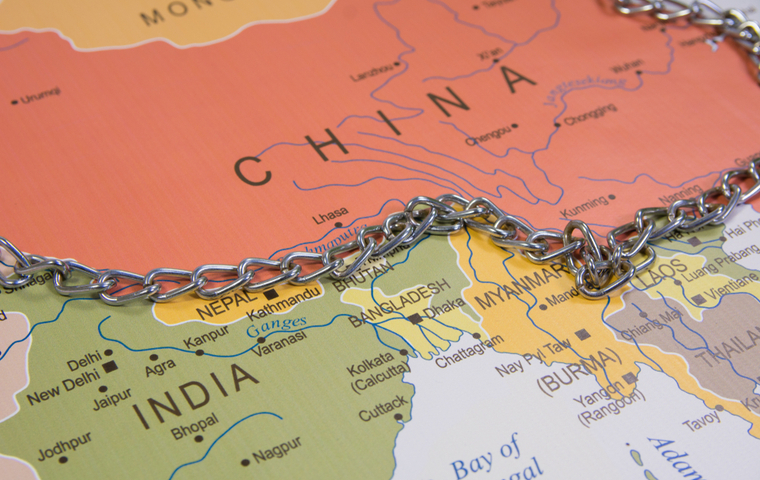Extended Deterrence in Northeast Asia Needs Tokyo-Washington-Seoul Operational Boost
Related Articles

Extended deterrence, which involves nuclear weapons, has two dimensions: the hardware aspect, concerning the number, capability, and deployment of nuclear weapons, and the software aspect, concerning planning and consultation. Although discussions on nuclear deterrence often center around the hardware perspective, in practice, it functions through hardware and software interactions, and we need to view both sides.
In Europe, Nuclear Presence Spurred Operational Development
Historically, U.S. extended deterrence in Northeast Asia has developed in a way quite different from that in Europe.
After World War II, the Soviets had an upper hand in the conventional forces balance in Europe. To turn the tables, the North Atlantic Treaty Organization (NATO) had relied on the forward-deployed U.S. nuclear weapons (Euro-theater nuclear weapons) since their installment. Thus, the credibility of extended deterrence in NATO depended on when, where, and how U.S. nuclear weapons should (or should not) be used, which has inevitably led to the development of consultative mechanisms within NATO. The serious situation where nuclear weapons could be used has also played a part in generating discussions on security involving not only policymakers but also the entire public.
Meanwhile, in Northeast Asia, the issues on nuclear strategy had been a lesser national concern compared to Europe. There are several reasons for this. First, because the Cold War’s primary theater was in Europe, and Asia was a secondary theater that would receive knock-on effects if war broke out in Europe, the region’s priority was low within the nuclear strategy.
Second, in Europe, on the same continent as the Soviet Union, ground forces such as tanks and artillery were highly important, and the West allowed Moscow to gain an advantage in this light. Meanwhile, in Northeast Asia, the naval and air forces were vital, and since the Western Bloc consistently had an edge in the conventional forces balance against the Soviets in Cold-War era Asia, the dependence on nuclear weapons was relatively smaller.
Third, Northeast Asia did not have a multilateral security framework like NATO, and the U.S.’s bilateral alliances with Japan and South Korea had long been the core structure. Thus, the nature of the alliances was prone to fluctuate with the domestic circumstances in the two countries. Especially for Japan, the nuclear weapon is an extremely sensitive issue, and together with its three non-nuclear principles (restricting possession, manufacturing, and introduction), it was difficult to have discussions open to the public. Moreover, most of the nuclear weapons deployed in Asia during the Cold War were in Okinawa and South Korea. Until 1972, Okinawa remained under U.S. occupation, and the Japanese government continued to avoid mentioning the nuclear presence head-on. The Eisaku Sato administration’s negotiations to regain Okinawa shed light on the treatment of Okinawa’s nuclear weapons. But the weapons were removed when the island was returned to Japan, and the issue garnered limited interest.
Although nuclear weapons had been deployed in South Korea since the onset of the Cold War, Washington did not officially admit this until 1975. In 1991, the senior Bush administration announced the Presidential Nuclear Initiatives (PNIs) and decided to remove all ground-based and surface-based nuclear weapons from Asia, thus eliminating U.S. nuclear weapons from Northeast Asia. This physical “absence” partly worked to put off the development of extended deterrence operations.
North Korea’s Nuclear Development and Tokyo-Washington-Seoul’s Discord

The advancements in North Korea’s nuclear and missile technologies in the late 2000s was a wakeup-call to the state of “nuclear forgetting” in post-Cold War Northeast Asia. In the face of the North Korean nuclear threat and the emergence of China as a force challenging the status quo, Japan and South Korea became increasingly concerned about the reliability of extended deterrence. In 2010, the Barack Obama administration began regular bilateral dialogues on extended deterrence to understand the concerns of Tokyo and Seoul and work together to seek measures. These are the current Japan-U.S. Extended Deterrence Dialogue and the U.S.-South Korea Extended Deterrence Strategy and Consultation Group (EDSCG). Washington also urged both countries for a swift conclusion of the General Security of Military Information Agreement (GSOMIA), with the aim of strengthening Tokyo-Washington-Seoul cooperation from an operational perspective.
However, progress in the trilateral cooperation had been slow. One reason is South Korea’s domestic problems. In June 2012, on the signing day of the GSOMIA, the Lee Myung-bak administration canceled it due to parliamentary affairs, and the following Park Geun-hye stepped down with a scandal. The subsequent Moon Jae-in administration focused on improving relations with North Korea, and talks between Washington and Seoul stalled, not to mention trilateral dialogues. To top it all off, Tokyo-Seoul relations plunged to “the worst in the postwar era.” In the first place, Tokyo and Seoul have different priorities on threats. For Seoul, the biggest threat is Pyongyang, and its concern remains within the Korean peninsula. Meanwhile, Japan is threatened by not only North Korea but also China. Particularly since the Senkaku Island dispute in 2010, extended deterrence was recognized in a broader sense not limited to nuclear weapons. For these reasons, the condition for deepening the Tokyo-Washington-Seoul trilateral relations did not mature during the Obama and Donald Trump administrations.
The Steps to Take in a “Planetary Alignment” Opportunity
Looking back on this history, the current situation is a perfect opportunity to develop the operational aspect of extended deterrence in Northeast Asia, with a “planetary alignment” coincidence of having administrations in Tokyo, Washington, and Seoul that value alliance relations and share a broad security perspective.
Then, what should be discussed? The first issue is recovering and deepening trilateral or bilateral dialogue and consultation mechanisms. Since President Yoon Suk Yeol’s visit to Japan in March 2023, dialogues at various levels have revived in Japan and South Korea. Also, the Washington Declaration announced at the U.S.-South Korea summit in May 2023 contains many of the points that Japanese and South Korean experts have been advocating for the past few years. In particular, the establishment of the Nuclear Consultative Group (NCG), a mechanism to expand opportunities for South Korean political and military involvement in U.S. nuclear operational planning and execution, would be a major step forward if it functions as expected.
Some have expressed regret that South Korea outpaced Japan, but this is not like the U.S. compared the two and chose South Korea. As revealed at the Japan-U.S. Extended Deterrence Dialogue held in late June 2023, Japanese and U.S. authorities have been conducting tabletop exercises on extended deterrence on a regular basis. Washington seeks to equally strengthen its relationship with the two countries. Despite minor differences, if it wished, Japan could mirror U.S.-South Korean measures, and vice versa. However, when calmly considering the balance between effective deterrence and psychological reassurance, measures toward South Korea, such as port calls by strategic nuclear submarines, are not always desirable for Japan. Tokyo should seek its own optimal solution without being overly concerned about Seoul.
Then, will deepening the Tokyo-Seoul and Washington-Seoul extended deterrence dialogue pave the way for a trilateral dialogue? I believe it would be desirable, but there are several issues that need to be addressed before reaching that stage. Leaving aside the political factor of whether trilateral-cooperation-oriented administrations will continue in each country, a redesign of the command-and-control mechanism in the event of a contingency is inevitable if trilateral dialogue is to be pursued in earnest. In the event of a contingency on the Korean Peninsula, the U.S.-South Korea alliance would need Japan’s indirect support, and North Korea would most likely use nuclear intimidation toward Japan. If this is so, the U.S. and South Korea must properly reflect the magnitude of the risk Japan would assume and allow Japan’s involvement in the contingency planning and execution process. This is a major challenge that Washington and Seoul have not accepted for a long time. At the same time, the U.S. needs to organize and improve the coordination and command-and-control of the Commander of U.S. Forces in Korea (Commander of U.S.-ROK Combined Forces), Commander of Indo-Pacific Command (INDOPACOM), and Commander of Strategic Command (USSTRATCOM, in charge of nuclear weapons operations).
In addition, in terms of enhancing the operational aspects, we should deepen the opportunity to verify in detail whether a seamless operational plan integrating nuclear and non-nuclear elements will work, with continuous updates. A mere several-hour tabletop exercise twice a year has limitations. The important thing is to gain a higher level of political commitment. Incumbent Secretary and Deputy Secretary of State attended the Obama administration’s tabletop exercise in 2016, which assumed a Russian re-invasion of Eastern Europe. It would be essential to conduct exercises based on the same scenario at the cabinet, undersecretary, and staff-levels, and to share the issues and differences in results. It would also be worthwhile to establish permanent training opportunities for mid-level officers of the Foreign Affairs and Defense Ministries and Self-Defense Forces to systematically learn the process of planning and executing nuclear programs. And cooperation between Tokyo, Washington, and Taipei will be indispensable in preparing for a Taiwan contingency.
Lastly, I would like to add a few words about the hardware aspect. Like the Obama administration, the Joe Biden administration wants to reduce the role of nuclear weapons in security policy and is reluctant in introducing and deploying new nuclear weapons. The Trump administration announced the nuclear-armed sea-launched cruise missile (SLCM-N) program in the 2018 Nuclear Posture Review (NPR). The Biden administration cancelled this in the 2022 NPR. This is a measure that leaves some concerns, in terms of countering the growing theater nuclear arsenals of Beijing and Pyongyang and providing reassurance to the allies. An alternative option needs an urgent consideration.
This is a translation of the Japanese article published in vol. 80 (Jul./Aug. 2023) of the Gaiko (Diplomacy) magazine.
Masashi Murano has worked on strategic intelligence analysis and policy planning at the Okazaki Institute and government agencies, then joined the Hudson Institute as a researcher in 2019. He specializes in Japan-U.S. security policy, nuclear and missile defense policy, and deterrence theory. He is the co-author of Aratana misairu gunkakukyoso to nihon no bouei [The New Missile Arms Race and Japan’s Defense], Alliances, Nuclear Weapons and Escalation: Managing Deterrence in the 21st Century and other books.




